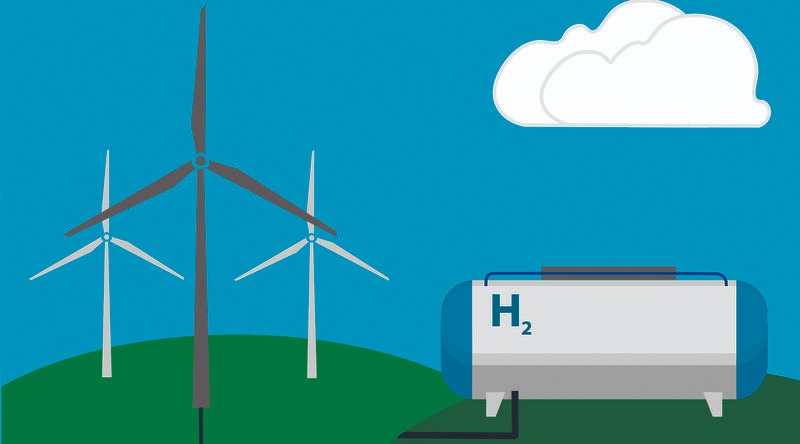The Union Cabinet in India approved a National Green Hydrogen mission, with a budget of ₹19,744 crore, that aims to make India a global hub for using, producing, and exporting green hydrogen.
What Is Green Hydrogen?
Hydrogen is a key industrial fuel with a variety of applications, including the production of ammonia, steel, refineries, and electricity. However, the hydrogen that is currently being produced is known as “black or brown” hydrogen, which is produced from coal.
Grey hydrogen is produced from natural gas, and “blue” hydrogen is produced from fossil fuel sources where the carbon emissions are captured through carbon-capture processes.

Green hydrogen is produced through electrolysis, which is the process of splitting water into hydrogen and oxygen using electricity generated from renewable energy sources such as solar or wind. This is the most environmentally sustainable way of producing hydrogen.
What Is The Caveat?
Green hydrogen currently accounts for less than 1% of global hydrogen production due to its high production cost.
A kilogram of black hydrogen costs $0.9-1.5 to produce, while grey hydrogen costs $1.7-2.3 and blue hydrogen can cost anywhere from $1.3-3.6. In comparison, green hydrogen costs $3.5-5.5 per kg, according to a 2020 analysis by the Council for Energy, Environment, and Water.
What Is The National Green Hydrogen Mission?
The mission aims to incentivize the commercial production of green hydrogen and make India a net exporter of the fuel.
The mission has set a target to develop green hydrogen production capacity of at least 5 MMT (Million Metric Tonne) per year, alongside adding renewable energy capacity of about 125 GW (gigawatt) in the country.
This will involve decarbonizing the industrial, mobility, and energy sectors, reducing dependence on imported fossil fuels and feedstock, developing indigenous manufacturing capabilities, creating employment opportunities, and developing new technologies such as efficient fuel cells.
By 2030, the Centre hopes that its investments will bring in investments worth ₹8 trillion and create over six lakh jobs. Additionally, about 50 MMT per year of CO2 emissions are expected to be averted by 2030.
As per its Nationally Determined Contribution (NDC) to meeting the goals of the Paris Agreement, India has committed to reducing the emissions intensity of its GDP by 45% by 2030, from 2005 levels.
How Will The Mission Support Green Hydrogen Production?
The mission will “facilitate demand creation, production, utilization, and export of green hydrogen,” according to a press release from the Ministry for New and Renewable Energy. There are two umbrella sub-missions under the program.
The first is the Strategic Interventions for Green Hydrogen Transition Program (SIGHT), which will fund the domestic manufacturing of electrolyzers and produce green hydrogen. The second is to support pilot projects in emerging end-use sectors and production pathways.
States and regions that are capable of supporting large-scale production and/or utilization of hydrogen will be identified and developed as green hydrogen hubs.
The Ministry has allocated ₹17,490 crore for the SIGHT program, ₹1,466 crore for pilot projects and hydrogen hubs, ₹400 crore for research and development, and ₹388 crore for other parts of the mission.
What Are The Challenges Ahead?
Several major industrial houses have announced plans to facilitate India’s adoption of green hydrogen. However, they are all premised on India being able to access a reliable stream of components, upgrading the manufacturing and skill levels of its small and medium manufacturing enterprises and developing a transmission network that can supply the hydrogen produced from supply-spots to industrial centres across the country
Many advanced economies have also announced plans and policies to develop such an economy and given their advanced industrial infrastructure, can steal a march over India.
Green hydrogen development is still in the nascent stages globally and while India can take the lead in being a major producer, it doesn’t have the necessary infrastructure yet to execute all these intermediary steps. It also needs to announce incentives to convince enough users of industrial hydrogen to adopt green hydrogen.
It needs to develop supply chains in the form of pipelines, tankers, intermediate storage and last leg distribution networks as well as put in place an effective skill development programme to ensure that lakhs of workers can be suitably trained to adapt to a viable green hydrogen economy.
“Read Updated Daily Current Affairs, PIB And Editorial Here for UPSC 2023”
Legacy IAS Daily Current Affairs For UPSC
Legacy IAS Daily PIB Summary For UPSC
Legacy IAS Daily Editorial Analysis for UPSC
Legacy IAS YouTube Channel For Daily Current Affairs





